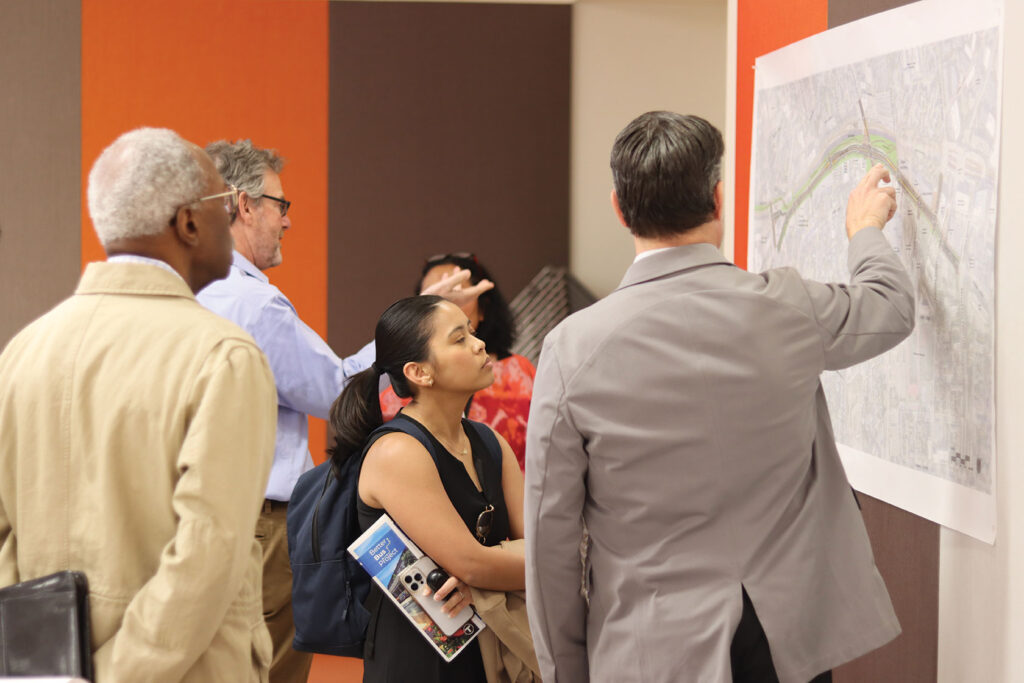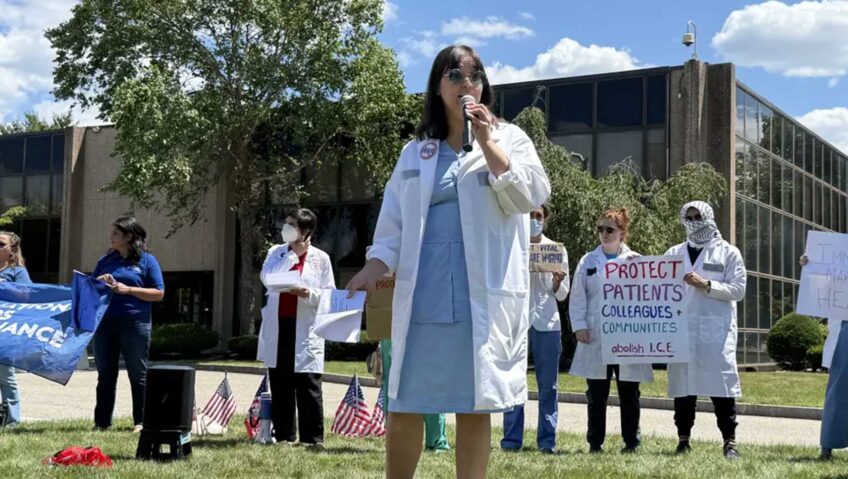
Residents have expressed mixed reactions to state and city plans to extend mid-road bus lanes on Columbus Avenue from Jackson Square to Ruggles Station, but have conceded the project’s inevitability.
MBTA bus riders said they saw benefits for their commute, while others at a May 24 open house at Roxbury Community College called the extension premature or worried about its permanence.
Residents have some cause for skepticism. Driven by the MBTA’s 2019 strategic plan, the extension jumped the priority queue established in the city’s 2017 comprehensive mobility vision. Popular early action priorities — including a Columbia Road greenway and Fairmount Line urban rail — remain years away.
Undaunted, state transit planners are at the wheel and the city of Boston is on board, budgeting $3.3 million for the extension of New England’s first center bus lanes. Two years ago, they opened from Jackson Square to Walnut Avenue. The extension is part of the MBTA’s Better Bus project.
For now, the road ahead seems clear, with green signals lighting the way.
A MBTA official at the open house noted that passenger vehicles have posed safety problems on Columbus Avenue.
“We are really trying to calm traffic,” said Phillip Cherrie, a senior project manager with the MBTA. He said Columbus Avenue to Tremont Street is a high-crash corridor where top vehicle speeds have hit 75 mph.
Cherrie said the bus lane project would expedite bus trips through the corridor and directly benefit bus riders leaving Nubian Square for Ruggles Station and people commuting to the Longwood area from Jamaica Plain and Roxbury.
Cherrie predicted future benefits would extend systemwide. Skirting traffic in 1.2 miles of new dedicated bus lanes, trips through the whole extension could run up to 12 minutes faster. If so, the MBTA could maintain the frequency of buses using the avenue and could redistribute any buses no longer needed there.
“That bus could be used somewhere else in the system to provide additional service,” he said.
The Columbus Avenue corridor lies at the heart of Boston’s bus nexus.
“All three of the highest-ridership bus routes travel within the project area right now,” Cherrie said. On either end of the planned extension, those bus routes navigate across Boston’s radial network briefly on Columbus Avenue. A single route fully traverses the extension today: the 22 bus.
A different part of the MBTA’s Better Bus Project plan will reroute the MBTA’s most-used route — the 28 from Blue Hill Avenue — across Columbus Avenue towards Longwood Medical Area, instead of turning onto Columbus Avenue enroute to Ruggles Station.
The Better Bus Project began with a state-of-the-system report and market analysis, which identified Longwood as one of Boston’s four major employment districts. There, it said, limits on public transit pose “an increasingly urgent challenge for attracting employees.”
Before the pandemic, a Better Bus demonstration would have extended the 29 bus route to serve Longwood. In May 2022, its new map contemplated cutting route 29 to a shuttle between Franklin Field and Ashmont station. That map was revised after community opposition.
One attendee at last week’s open house, Pamela Bush Miles, had helped galvanize that pushback. The Roxbury resident and T Riders Union organizer had distributed surveys, engaging 500 Bostonians about the redesign of the Boston bus network and, specifically, the 29 bus. The route was revised in November to connect Franklin Field and Jackson Square.
In December, the MBTA’s federally mandated Title VI equity analysis found that even revised changes potentially favor households earning more than $78,000 a year. This past April, the MBTA’s methodology was amended so as not to measure that way again.
Columbus Avenue’s first-phase bus lanes relied on two years of outreach for Go Boston 2030 and PLAN: JP/ROX. Both were published in early 2017.
Serving Longwood Medical Area
The center bus lane extension traces to the Longwood Collective, a group of medical institutions, schools and a museum in the area. The influential association operates shuttles to employers in the Longwood Medical Area. It also advocates for its own public transit.
The MBTA is strategically aligned with the Longwood Collective. The agency’s strategy prioritizes Longwood so they can “reach their full economic potential” and drive regional economic growth.
Institutions in the Longwood Medical Area identified transportation strategies for Go Boston 2030. The Collective conducted surveys to quantify support for the effort.
Even so, Go Boston 2030 does not recommend Columbus Avenue’s extended bus lanes, only the Complete Streets revamp already completed in the other section. It envisioned bike lanes from Back Bay Station to Boston Common and synchronized traffic signals on Columbus Avenue.
Thousands of residents helped imagine the top priorities in the 2030 citywide mobility vision. Some of those would have served Boston’s historically marginalized neighborhoods of Dorchester and Roxbury.
The MBTA’s strategic plan even acknowledges they suffer a “mobility disparity,” where bus-only communities lack rapid transit. Existing bus routes link up to the Orange and Red lines.
In contrast, the Longwood Medical Area is served by two Green Line branches. It has Boston’s lowest level of car-commuting, 6.6%, according to Go Boston 2030.
The Collective prides itself as a national leader in transportation demand management, with methods to discourage driving. Its representative observed last week’s open house.
Mixed opinions
At the meeting, project consultant David Lee fielded resident questions.
“Essentially, it’s skinny-ing down the road — the car aspect of the road— and allowing, therefore, additional green space,” he told the Banner afterwards.
Lee leads an architecture firm that has a hand in developments from Egleston Square to Ruggles Station. His firm, Stull and Lee, designed a 26-story tower for Nubian Square. It wrote Roxbury’s strategic master plan and designed Roxbury Community College’s campus along Columbus Avenue.
The new green space, he said, will buffer sidewalks on the Mission Hill side of the avenue to entice pedestrians out of bike lanes.
Lee acknowledged that it’s not easy to come up with transportation solutions that please all users.
“There are going to be people who are not going to be happy with the results and there are people who are going to be ecstatic, because it makes their commute better,” Lee said.
Robert Ambrose of Dorchester agreed the bus lane extension “seems like a good idea.” He travels Boston by bus and The Ride, the MBTA’s door-to-door service for the disabled and elderly.
Other attendees remained skeptical after the open house.
“It almost feels like they are doing the second step before the first step,” said Beinborn Martin of Mission Hill. “The bus lanes are a little premature.”
Allison Pultinas, also of Mission Hill, was concerned about expensive changes.
“When you do infrastructure like this, it’s very permanent,” she said.
Miles was distributing new surveys at the open house. The Transit Riders Union is collecting rider feedback through next fall for a report on the bus network overhaul. One week in, she counted 50 responses. Still, she said the proposed changes could be inevitable.
“This thing that is going down the middle of the street is going to move forward, I’m sure, whether we come to the meetings or not,” Miles said.







